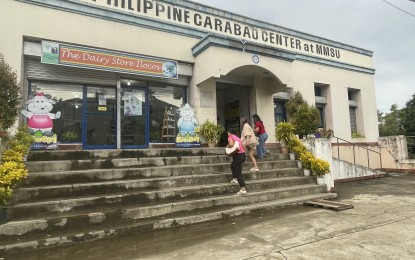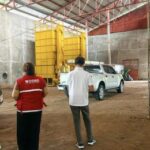LAOAG CITY – The Philippine Carabao Center is expanding its carabao upgrading program to the different towns of Ilocos Norte with the help of local government units to boost rural income.
Carabao milk production in the Ilocos Region has doubled in the past three years.
“From 50,000 liters per year, we are now producing 100,000 liters and we are still in the month of October,” the director said.
He credited the national government’s program on genetically improving the Philippine carabao breed, which produced 145,181 genetically improved calves in the last five years.
Approximately 90% of these calves are meant for milk and meat purposes, while the remaining 10% is for draft power.
In Ilocos Norte, some of the animals were entrusted to farmers’ organizations such as in Dingras and Badoc towns. Farmers in these areas are now harvesting milk to supply the local market.
Aside from milk production, the PCC is also helping farmers market their products by linking them to institutional buyers and government feeding programs like the Department of Education’s School-Based Feeding Program and the Department of Social Welfare and Development’s Supplementary Feeding Program.
This market channel alone has generated PHP2.4 billion from 2019 to 2024 for the SBFP and PHP504 million from 2020 to 2024 for the SFP nationwide.
With this development, other LGUs in the province have manifested their support to boost dairy farming industry by allocating funds for the purchase of carabaos for milk production.
Initially, the Pagudpud government has purchased 20 female crossbred buffaloes to jumpstart dairy farming in Barangay Caparispisan. This will soon be added with additional 100 buffaloes from the Philippine Coconut Authority to be funded under the coconut levy fund.
There is also an ongoing livestock enterprise and economic development project with 20 buffaloes to boost carabao milk production in Dingras town. The project is being undertaken by the PCC in collaboration with the municipal government and the Mariano Marcos State University.
From PHP63.27 in 2020, a liter of raw carabao milk is now pegged at PHP84.87. Carabao milk and carabao-based products are also gaining popularity in the local market as it being promoted in government-organized trade fairs as well as in Kadiwa stores.
Philippine Carabao Center
The Philippine Carabao Center (PCC) is a government agency established in 1992 to promote the development of the Philippine carabao (water buffalo) as a source of milk and meat to support the livelihood of rural farmers. Through research and genetic improvement programs, it has transformed the carabao’s role from primarily a farm draft animal into a key component of the country’s growing dairy industry.
Ilocos Norte
Ilocos Norte is a province in the northern Philippines renowned for its rich history and Spanish colonial architecture. It is famously the birthplace of former President Ferdinand Marcos and is home to iconic landmarks like the Paoay Church, a UNESCO World Heritage Site, and the Cape Bojeador Lighthouse. The area’s history is deeply intertwined with Spanish colonization, which began in the 16th century, leaving a lasting cultural and architectural legacy.
Batac City
Batac City is a first-class component city in the Philippines, located in the province of Ilocos Norte on the island of Luzon. It is historically significant as the birthplace of former Philippine President Ferdinand E. Marcos, whose preserved body lies in a glass tomb in the Marcos Museum and Mausoleum. The city is also known for its agricultural heritage, particularly as the “Home of the Great Ilocano Empanada,” a popular local delicacy.
Barangay Tabug
I am unable to provide a specific summary for Barangay Tabug, as this is a common name for many villages across the Philippines. A barangay is the smallest administrative division in the country. To give an accurate description, more specific details, such as the municipality or province it is located in, would be needed.
Dingras
Dingras is a municipality in the Ilocos Norte province of the Philippines, historically known as a major rice-producing region. It was a significant settlement even before the Spanish colonization and is remembered for the Dingras Church, originally built in the 17th century, which was largely destroyed by an earthquake but whose ruins still stand as a historical landmark.
Badoc
Badoc is a municipality in the province of Ilocos Norte, Philippines, most famous as the birthplace of the country’s national hero, José Rizal. Its primary cultural site is the Rizal Shrine, a replica of the ancestral house where Rizal was born, which now serves as a museum showcasing his life and works.
Pagudpud
Pagudpud is a municipality located on the northern tip of Luzon in the Philippines, renowned for its pristine white-sand beaches like Saud Beach, often called the “Boracay of the North.” Historically, it was a remote area primarily inhabited by the Ilocano people, with its development as a tourist destination growing significantly in the late 20th century. The area is also known for the Bangui Windmills, a landmark wind farm located nearby.
Mariano Marcos State University
Mariano Marcos State University (MMSU) is a public university in Batac, Ilocos Norte, Philippines, established in 1978. It was named after Mariano Marcos, the father of former President Ferdinand Marcos, and was created through a presidential decree to provide higher education in the Ilocos Region. The university has since grown into a prominent institution offering a wide range of academic programs.






